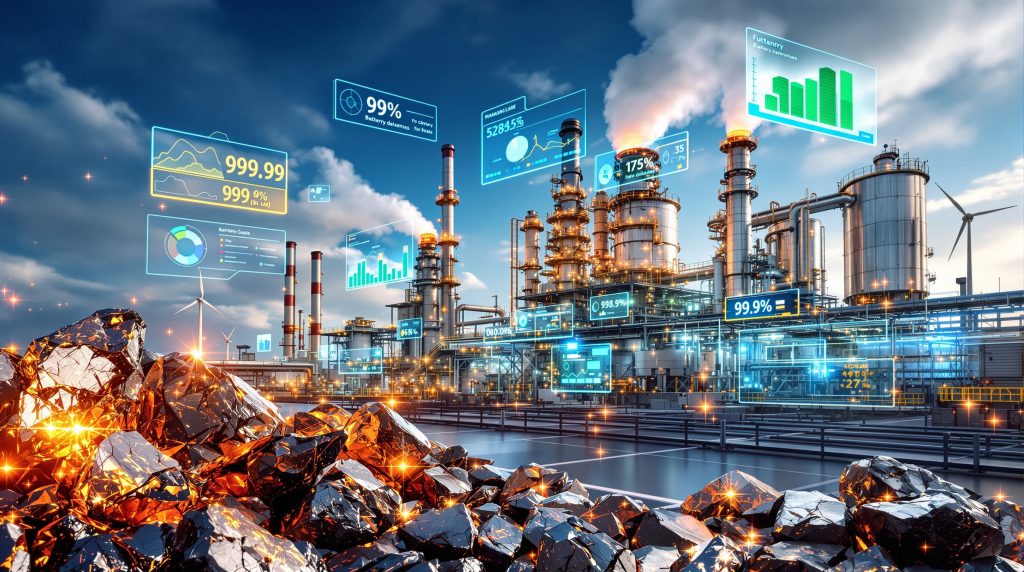Manganese processing technologies have become increasingly crucial as global demand for high-purity manganese intensifies, particularly driven by the electric vehicle battery sector and energy storage applications. This transformation has catalysed innovation across extraction, purification, and environmental management methods. Furthermore, the competitive landscape is being reshaped by advances in mining decarbonisation benefits and strategic supply chain diversification efforts worldwide.
What Are the Core Technologies Behind Modern Manganese Processing?
Modern manganese processing relies on two principal technological routes: hydrometallurgical and pyrometallurgical systems. Each method addresses different market needs, ore types, and purity standards with varying degrees of effectiveness.
Hydrometallurgical Extraction Systems
Sulfuric acid leaching represents the cornerstone of extracting manganese from complex ores. By dissolving manganese oxides under controlled pH and temperature conditions, recovery rates of 85–95% can be achieved for most ore types. This method proves particularly effective for processing lower-grade or polymetallic ores due to its selectivity and adaptability.
Multi-stage purification protocols incorporate sequential precipitation, cementation, and ion exchange processes. Each stage systematically removes specific contaminants including iron, copper, cobalt, nickel, and zinc by adjusting pH and redox conditions in carefully staged reactors.
Specialised extractants like LIX841 selectively bind manganese ions in acidic solutions. This targeted approach minimises cross-contamination, although proprietary extractant chemistries are increasingly prevalent in commercial operations. Additionally, ion exchange resins are applied to polish manganese solutions to battery-grade specifications.
Pyrometallurgical Processing Routes
Electric furnace smelting remains the mainstay for ferromanganese and silicomanganese production, operating above 1,600°C and typically consuming 4,000–6,000 kWh per tonne of product. This process suits high-grade ores and offers high throughput capabilities.
Controlled roasting technologies initiate the conversion of manganese minerals into more easily reducible forms. Effective roasting requires precisely managed temperature and atmosphere profiles to minimise manganese loss and optimise reduction efficiency.
Electrolytic methods produce electrolytic manganese dioxide (EMD) and cathode manganese dioxide (CMD) using high-purity solutions derived from hydrometallurgical processes. Electrochemical deposition achieves theoretical manganese purities exceeding **99.9%**—essential for electronics and battery markets.
How Do Different Ore Types Influence Processing Technology Selection?
Manganese ore characteristics, particularly grade and impurity profile, dictate the optimal processing pathway and investment strategy. Consequently, understanding these factors is crucial for technological decision-making.
Low-Grade Ore Processing Strategies
Beneficiating low-grade ores improves economic viability and reduces downstream reagent consumption. Techniques such as gravity separation can recover 75–90% of manganese minerals, whilst magnetic concentration and froth flotation are tailored to specific mineralogy and particle characteristics.
Economic viability thresholds vary considerably, but direct processing typically becomes unviable below approximately 30% manganese content. However, upgrading concentrates above 50–55% manganese significantly improves downstream recovery rates and reduces acid consumption.
Moreover, bioleaching applications utilise microbial oxidation pathways to selectively leach manganese from low-grade ores. This approach potentially reduces carbon footprint and chemical input requirements under controlled conditions.
High-Grade Ore Optimisation
Processing high-grade ores (typically >50% Mn) enables direct smelting with minimised preprocessing steps. This approach reduces energy consumption by 15–25% compared to beneficiated routes whilst lowering overall capital investment.
Quality control parameters become critical when operating smelters with high-grade feed. Tight control of input composition, furnace profiles, and slag chemistry prevents yield drift and impurity inclusion.
Which Purification Methods Achieve Battery-Grade Manganese Standards?
High-purity manganese is indispensable for advanced battery chemistries. Achieving sub-ppm impurity control requires sophisticated purification technologies that address specific contaminant removal requirements.
Chemical Purification Pathways
Multi-step precipitation selectively removes each impurity within its optimal pH window. Iron is typically removed at pH 2.5–3.5, whilst nickel and cobalt require pH ranges between 4.5 and 6.5, and zinc around 5.5–7.0.
Advanced chelating resins refine manganese sulfate solutions to >99.9% purity post-precipitation. This level of purity is essential for lithium-ion battery cathodes, where key impurity limits for nickel, cobalt, iron, and copper must remain under 100 ppm.
Crystallisation optimisation engineers particle size and morphology during the final processing stage. This produces narrow, micron-scale distributions that improve electrochemical stability in battery applications.
Advanced Separation Technologies
Nanofiltration and reverse osmosis membranes with molecular cutoffs between 200–1,000 Da remove remaining multivalent impurities. Membrane fouling mitigation strategies, including prefiltration and antiscalant dosing, extend membrane life cycles and reduce operational costs.
Advanced electrochemical refining achieves >99.9% manganese dioxide through selective electrodeposition. Cell current efficiencies often exceed 85%, making these methods increasingly attractive for high-value applications where traditional processing bottlenecks need addressing.
What Role Does Environmental Technology Play in Modern Manganese Processing?
Environmental stewardship has become integral to regulatory compliance and market access. In addition, sustainable practices increasingly influence investment decisions and operational strategies across the sector.
Waste Minimisation Strategies
Modern plants target minimal tailings ratios, often achieving 1:1 or better performance whilst promoting tailings reprocessing for building materials. This approach significantly reduces environmental burden and creates additional revenue streams.
Closed-loop water systems aim for 85–95% recirculation rates, drastically reducing freshwater withdrawals and enabling compliance with strict effluent standards. Furthermore, implementing comprehensive waste management solutions enhances overall environmental performance.
High-performance scrubbers and gas treatment facilities control SO2, particulate, and NOx emissions from pyrometallurgical reactors. These systems ensure compliance with increasingly stringent emission standards worldwide.
Sustainable Processing Innovations
Renewable energy integration, including solar arrays demonstrated in China's Zhongning County, directly powers beneficiation and electrolysis operations. This approach substantially reduces indirect emissions and operational costs.
Advanced energy recovery systems, combined with low-carbon reductants and electrified process heat, incrementally lower greenhouse gas emissions. These innovations align with global mining decarbonisation benefits and sustainability objectives.
Circular economy principles involve recycling spent batteries, industrial residues, and off-specification manganese products. This approach reintegrates valuable metals and closes material flow loops, supporting long-term resource sustainability.
How Do Processing Technologies Impact Product Quality and Applications?
Process design and operational discipline directly determine final product suitability across diverse industrial applications. Consequently, understanding these relationships is essential for market positioning and customer satisfaction.
Battery-Grade Specifications
Lithium-ion battery cathodes, particularly for NMC and LMNO chemistries, require 99.95%+ manganese purity. Transition metal impurities must remain below 100 ppm, with stringent controls on calcium, sodium, and magnesium content.
Uniform, sub-10 µm crystals with precisely controlled morphology maximise surface area and improve cathode stability. These specifications directly influence cycle life and electrochemical performance in demanding applications.
Automated dosing systems and inline spectral analysis minimise process deviations, preventing performance-degrading elements from persisting in final products. This level of control becomes increasingly important as battery specifications tighten.
Industrial-Grade Applications
Ferromanganese and silicomanganese must meet specific alloying standards for carbon, phosphorus, and sulfur content. These specifications prove integral to steel strength and formability characteristics required by downstream manufacturers.
Electrolytic manganese dioxide for batteries and manganese sulfate for fertilisers follow established impurity and particle size constraints. These requirements align with downstream synthesis processes and quality assurance protocols.
Pharmaceutical and electronic-grade manganese demands even higher purities, sometimes requiring bespoke crystallisation and filtration systems. These specialised applications command premium pricing but require substantial quality investments.
What Are the Economic Considerations in Technology Selection?
Capital and operating expenses fundamentally shape investment decisions for manganese processing technologies. However, understanding the broader economic landscape requires analysis of current mining trends & innovations affecting the sector.
Capital Investment Analysis
Hydrometallurgical plants require extensive liquid-handling, precipitation, and ion-exchange systems representing medium capital intensity. In contrast, pyrometallurgical routes demand high-capacity furnaces and robust off-gas control systems with higher upfront costs.
Hydrometallurgical systems offer modularity advantages, making them ideal for staged scale-up strategies. Pyrometallurgy benefits from economies of scale but lacks flexibility when feed quality or market focus shifts unexpectedly.
Both approaches require reliable power, water, and transportation infrastructure. Proximity to ore sources and downstream customers reduces logistics costs and often justifies substantial capital outlays.
Operating Cost Optimisation
Pyrometallurgical plants typically consume more energy, with significant savings possible through heat recovery integration. Hydrometallurgical and electrochemical routes benefit from renewable energy integration and advanced process control systems.
Acid, neutralising agents, and specialty extractants represent primary operating expenses for hydrometallurgical operations. Meanwhile, electrode maintenance and reductant costs take precedence in electrochemical and pyrometallurgical facilities.
Automation and advanced analytics reduce direct labour requirements whilst improving process consistency. However, skilled technical operators remain critical for troubleshooting, quality assurance, and preventive maintenance activities.
How Are Processing Technologies Evolving for Future Demand?
Anticipating surges in battery demand and stricter regulatory controls, the manganese sector is positioning for rapid technological advancement. Furthermore, emerging technologies promise to revolutionise operational efficiency and product quality standards.
Emerging Technology Trends
AI in mining operations is being piloted for predictive control in hydrometallurgy, optimising acid dosing, throughput, and impurity removal in real-time applications.
Integrated distributed control systems (DCS) and internet-of-things (IoT) sensors enable minimal human intervention whilst boosting uptime. These systems support remote monitoring capabilities and predictive maintenance protocols.
Spectroscopic analysis stations using XRF and AAS technologies enable continuous quality tracking. These systems catch deviations before they propagate to final product streams, ensuring consistent quality standards.
Market-Driven Innovations
Processing plants increasingly tailor output to battery-grade standards, investing in purification systems that can adapt to emerging cathode chemistries. This flexibility becomes crucial as battery technology continues evolving rapidly.
Diverse ore-sourcing strategies combined with on-site beneficiation capabilities empower operators to mitigate geopolitical and logistical risks. This approach supports supply chain resilience and operational continuity.
Designing facilities with future regulatory tightening in mind reduces risks of costly retrofits. Forward-thinking operators incorporate advanced emission control and effluent treatment systems from initial construction phases.
What Quality Control Measures Ensure Processing Efficiency?
Comprehensive quality assurance frameworks underpin competitiveness and customer trust in manganese processing technologies. These systems integrate real-time monitoring with predictive analytics for optimal performance.
Analytical Testing Protocols
Inline X-ray fluorescence (XRF) and atomic absorption spectroscopy (AAS) platforms provide minute-by-minute elemental composition updates. This data feeds directly into automated process control systems for immediate adjustment capabilities.
Automated trending systems monitor pH, temperature, redox potential, and flow rates continuously. These parameters enable rapid responses to off-nominal conditions before they impact product quality or recovery rates.
Standardised testing protocols compare samples against battery and alloy manufacturer specifications with full batch-level traceability. This documentation supports quality certification and customer confidence requirements.
Process Optimisation Strategies
Statistical process control (SPC) systems utilise continuous data logging and analysis to identify deviations early. This approach enables proactive process adjustments that maintain optimal yield and quality performance.
Predictive maintenance programmes track equipment health parameters to forecast maintenance needs before failures occur. This strategy minimises unplanned downtime and extends equipment operational life significantly.
Integrated yield monitoring dashboards consolidate analytical and operational data to pinpoint recovery rates and guide incremental improvements. These systems support continuous optimisation and performance benchmarking activities.
Recent developments in battery recycling breakthrough technologies are creating new opportunities for secondary manganese recovery. These innovations complement traditional processing methods and support circular economy objectives in the battery supply chain.
Moreover, comprehensive processing methods continue evolving to meet increasingly sophisticated market demands. Industry leaders are investing heavily in research and development to maintain competitive advantages in this rapidly advancing sector.
Key Processing Technology Comparison
| Technology | Ore Suitability | Energy Requirements | Product Purity | Capital Investment |
|---|---|---|---|---|
| Hydrometallurgy | Low-grade, complex | Moderate | 99.5-99.9% | Medium |
| Pyrometallurgy | High-grade | High | 95-99% | High |
| Beneficiation | Variable grades | Low | Concentrate only | Low |
| Bioleaching | Low-grade | Very low | 95-98% | Low |
The manganese processing sector continues evolving rapidly, driven by technological advancement and market demand growth. Understanding these processing technologies becomes increasingly important for stakeholders navigating this dynamic landscape whilst maintaining competitive positioning in global markets.
As the industry advances, successful operators will combine traditional metallurgical expertise with emerging technologies and sustainable practices. This integrated approach ensures long-term viability whilst meeting increasingly stringent quality and environmental standards that define modern manganese processing requirements.
Furthermore, staying informed about advanced manganese beneficiation methods helps industry professionals understand global best practices and emerging technological solutions that shape future processing capabilities and market opportunities.
Looking to Capitalise on Manganese Processing Opportunities?
Discovery Alert's proprietary Discovery IQ model delivers instant notifications on significant ASX mineral discoveries, including manganese and battery metal breakthroughs that could transform processing operations. Begin your 30-day free trial today at Discovery Alert and position yourself ahead of the market as processing technologies continue advancing and demand intensifies.




